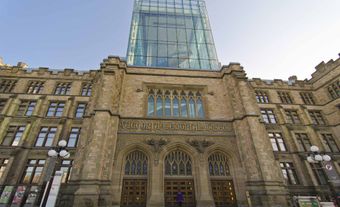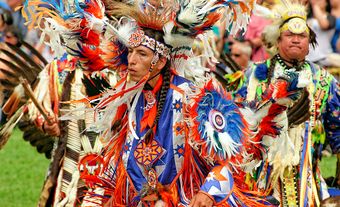Wiikwemkoong Unceded Territory is a reserve located on the eastern peninsula of Manitoulin Island in Ontario. The reserve is held by the Wiikwemkoong First Nation, which is composed of Ojibwe, Odawa and Potawatomi peoples. Together, these nations form the Three Fires Confederacy. As an unceded reserve, Wiikwemkoong has not relinquished its land through treaty or other means. (See also Reserves in Ontario.)
The Wiikwemkoong First Nation has a registered population of 8,330, with an on-reserve population of 3,208 (2020). Formerly known as Manitoulin Island Unceded Indian Reserve, the reserve changed its name to Wiikwemkong Unceded Indian Reserve in 1968 when it amalgamated with Point Grondine First Nation and South Bay First Nation. The name was changed again, in 2014, to its current name, though the federal government still refers to the reserve as the Wikwemikong Unceded Reserve.
Geography
With an area totalling 426.14 km², Wiikwemkoong Unceded Territory is the largest reserve in Ontario by area. Wiikwemkoong is located on the eastern peninsula of Manitoulin Island in Georgian Bay. It is accessible from the mainland via Highway 6.
Prior to European contact, the territory around the northern Great Lakes, including Manitoulin Island, was controlled by a loose confederacy of Anishinaabeg peoples: the Odawa, Ojibwe and Potawatomi. Their alliance was known as the Three Fires Confederacy. Manitoulin Island is also known as Odawa Mnis (Island), because of the large population of Odawa peoples who lived there.
The Wiikwemkoong band also owns Point Grondine Park on the mainland near Killarney, Ontario. Point Grondine has been unpopulated since the 1940s. In 2015, it was turned into a recreational park.
Manitoulin Island Treaty 1836
In 1836, Ojibwe and Odawa on Manitoulin Island made an agreement with the colonial government. This agreement is now known as the Manitoulin Island Treaty, the Bond Head Treaty, or sometimes as Treaty 45. At the time, Sir Francis Bond Head was lieutenant-governor of Upper Canada. Bond Head believed that colonial efforts to “civilize” First Nations and convert them to agriculture had failed and would continue to fail. He felt that rather than try to assimilate First Nations to European culture, the colonial government should instead separate Indigenous people from white people. Bond Head suggested protected parcels of land be made available to First Nations, but that the location of this land be remote and undesirable to settlers. By concentrating First Nation populations at specific locations, Bond Head aimed to further open up land for white settlement.

Bond Head visited Manitoulin Island in 1836 for the annual distribution gifts to the First Nations living there. Known as the King’s Presents, these gifts were designed to maintain relationships with Indigenous peoples. When he arrived, however, he decided to try to convince First Nations to agree to his plan. About 1,500 people gathered to hear Bond Head speak. In one of his speeches, Bond Head addressed the Ojibwe and Odawa specifically, and asked if they would give up their claim to Manitoulin and the surrounding islands in order to make them the property of any Indigenous person in Upper Canada who wished to live there. Bond Head then collected the signatures of 16 Ojibwe and Odawa leaders on the text of his speech.
The British colonial government accepted Bond Head’s signed speech as a legal agreement. While the agreement effectively made Manitoulin Island a reserve for all Indigenous people in Upper Canada, it did not, unlike other treaties, cede any Indigenous land to the Crown. In fact, it could be argued that the treaty strengthens First Nations’ claim to the land, as it names the islands as their property.
Manitoulin Island Treaty 1862
(courtesy Native Land Digital / Native-Land.ca)
Sir Francis Bond Head and other government officials hoped that following the Manitoulin Island Treaty, First Nations would migrate and settle on the island, thereby opening up land for white settlement. By 1860, the population of Manitoulin Island had grown, but not to the degree that the government expected.
While many First Nations were unwilling to move to the island, there were farmers who were. A shortage of farmland elsewhere in the province meant many farmers were eager to cultivate the island. The government realized that in order to open the island up to white settlement, First Nations needed to cede the land. In 1862, William McDougall, Superintendent General of Indian Affairs, visited Manitoulin Island to negotiate a treaty.
Wiikwemkoong First Nation refused to sign McDougall’s treaty. Other bands, however, did sign the agreement, which is sometimes referred to as the McDougall Treaty or Treaty 94. The treaty ceded the majority of Manitoulin and the surrounding islands to the government. In exchange, First Nations received reserves. Five reserves, in addition to Wiikwemkoong’s unceded land on the island’s eastern peninsula, were set aside.
Land Claim
In 1997, Wiikwemkoong First Nation submitted a specific land claim to the Ontario government. First Nations may file specific land claims when there is a treaty in place, but disagreement over the fulfillment of its provisions. In their land claim, Wiikwemkoong First Nation argues that the Manitoulin Island Treaty of 1836 affirmed the band’s right to the islands off the eastern shore of Manitoulin. Like Wiikwemkoong’s primary reserve, these lands were never ceded. Should a settlement be reached, approximately 105 km2 of land would be set aside as reserve lands for Wiikwemkoong First Nation.
Government and Politics
Wiikwemkoong Unceded Territory elects one chief and 12 councillors for a two-year term under the Indian Act’s electoral system. The community is working on implementing its own election law. In 2014, the First Nation ratified its constitution, Wiikwemkoong Gchi Naaknigewin, enshrining band member’s rights.
Arts and Culture
Notable people from Wiikwemkoong Unceded Territory include artist Daphne Odjig, water protectors Josephine Mandamin and Autumn Peltier, Indigenous women’s rights advocate Jeannette Corbiere Lavell, Federal Court of Canada judge Leonard S. Mandamin, musician Crystal Shawanda, actor Sladen Peltier, and chef Joseph Shawana.
In August, the reserve hosts the Wiikwemkoong Annual Cultural Festival, featuring traditional Anishinaabeg crafts, dance, cuisine and artwork. With the first event taking place in 1961, it is thought to be one of the longest-running powwows in northeastern North America.
Wiikwemkoong is also home to one of the longest-running Indigenous theatres in Canada, Debajehmujig Theatre Group. As the only professional theatre company located on-reserve in the country, Debajehmujig stages and produces works based on Anishinaabeg culture.
The First Nation also offers year-round cultural tours, including cultural teachings and tours of historic and natural sites.

 Share on Facebook
Share on Facebook Share on X
Share on X Share by Email
Share by Email Share on Google Classroom
Share on Google Classroom



